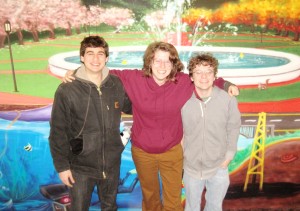For the month of January, three Oberlin College undergraduates – Dan Barella, Sayer Rippey, and Eli Rose – joined SCCL to work on extending our command-line tool for affect detection using machine learning, ALOE. The Winter Term internship was initially conceived by Katie Kuksenok, one of the two Oberlin alumni in SCCL; the other, Michael Brooks, also helped in mentoring the students while they were on campus.

Each of the visiting Obies contributed a new functionality and compared its performance to that reported in our CSCW report; Dan implemented a novel segmentation algorithm, Sayer extended feature extraction to process French chat messages rather than only English, and Eli worked on HMM classification. Having returned to Oberlin, Sayer continues to work on analyzing the French portions of the dataset as an independent research project, collaborating over distance.
It has been an incredible month. Besides being blown away by the Seattle public transit system, I got to learn so much about machine learning, language, and grad school, and I got to meet a lot of smart, passionate, inspiring people.
The work I did applying the ALOE pipeline to French was completely fascinating. It was great because I got to be doing something very practical, trying to get the labeler working for the rest of the pipeline, but it also brought up some really interesting differences between French and English.
– Sayer Rippey
So, here I am at the end of Winter Term. I’m already nostalgic! This project was really enrapturing, and the whole experience thoroughly enjoyable. … I will say that, I’m proud of the work I’ve done. There are some places where I know there’s room for improvement, but to believe otherwise would perhaps be worse. I can’t claim that it’s all perfect, but I can claim that I did nearly all that I set out to do, and then some that I hadn’t expected to do. I didn’t expect I’d have to put together a profiling script to test my project, and yet this turned out to be one of the most invaluable tools I’ve had for code analysis (hopefully for others as well). I didn’t expect to find such a subtle tradeoff between a small tweaking of time variables, and yet this became a central issue of the last two weeks of my project. I didn’t think comparing pipeline statistics would be so nuanced, but now I’m beginning to see all the ways that a visualization can change the way people perceive information. I could go on, but what I’m really trying to say is: I learned so many new things!
But the most exciting parts of this Winter Term were not the components of my project. They were the incredible people at the SCCL, who brought me to lectures and talks on the nature of artificial intelligence and information visualization, who always provided novel viewpoints and provoking discussions, who were dedicated to sharing their unbelievable experience in so many topics. I was honored to work with Eli, Sayer, Katie, Michael, Megan, Cecilia, and the rest of this great team. They’ve humbled and challenged me, and for that I thank all of them; as this term comes to a close, I hope only that I should be so lucky in pursuit of future endeavors as I was in finding this one. So to everyone at the SCCL, so long, and thanks for all the fish!
– Dan Barella



Leave a Reply
You must be logged in to post a comment.